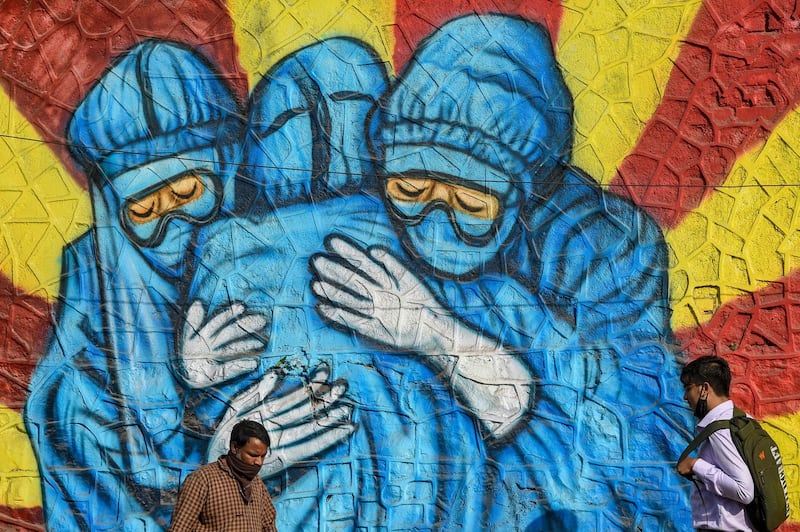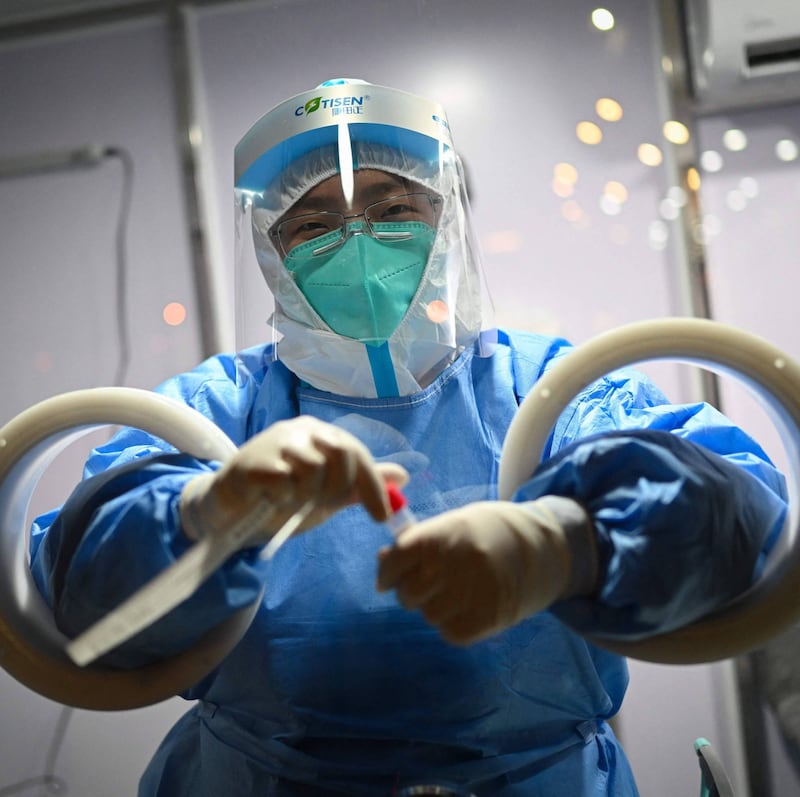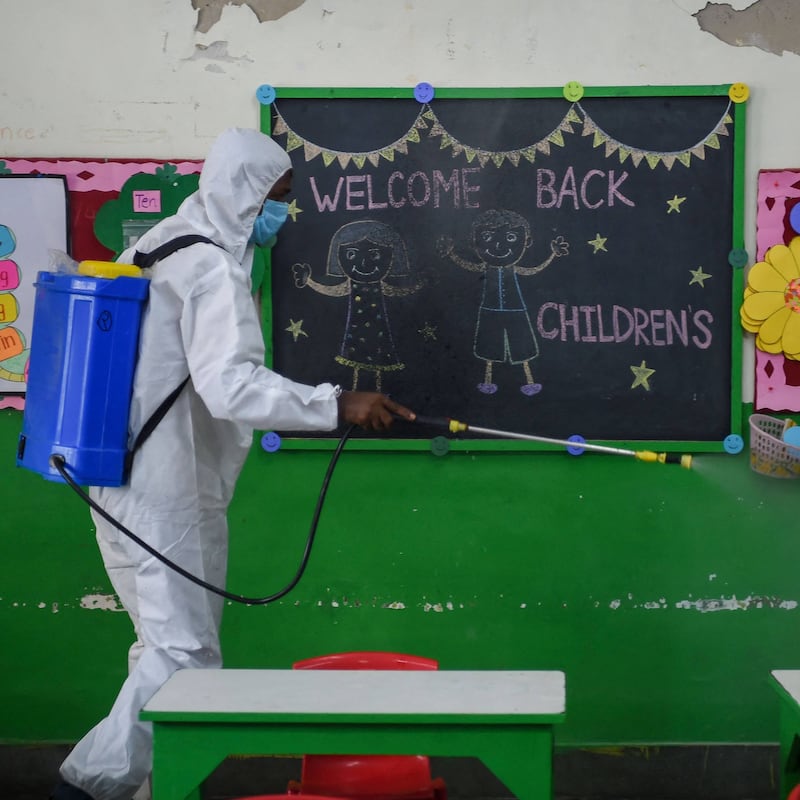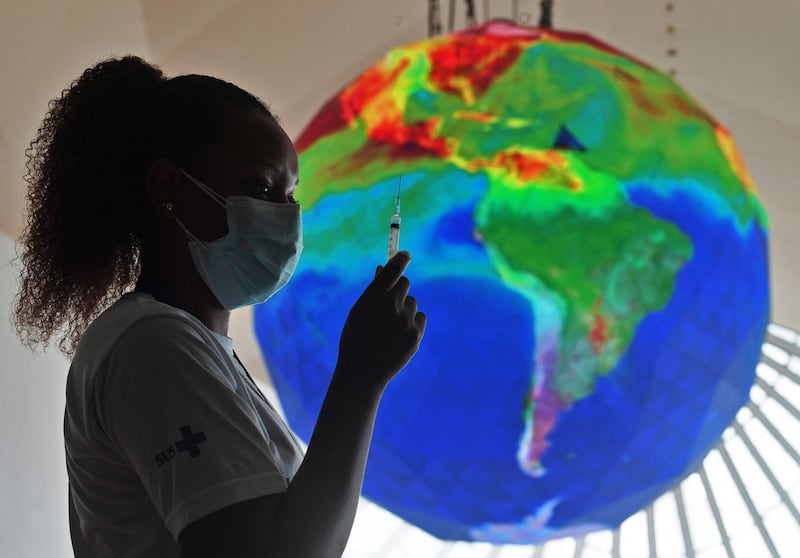All over the world people are asking the same question: is the pandemic over?
Hopes have risen due to the dominance of the less severe though more infectious variant Omicron, the proven effectiveness of vaccines in saving lives, and a global reduction in cases detected in the last week.
But the situation is highly uncertain, and assumptions that Covid-19 is history overlook that the number of deaths from the disease worldwide have risen for five consecutive weeks.
In the past week Covid-19 killed 68,000 people, a rise of 7 per cent compared with the same period prior. And those are only the deaths that are counted: in much of the world, deaths go unreported.
The global hotspot for Covid-19 fatalities is currently the United States, where daily deaths are close to the levels reached in last winter's peak.
The great concern is that in time a mutation could occur that is more infectious, and more deadly
“In the US in the last 24 hours, I was just looking at the number: 3,400,” Dr Abdi Mahamud, the World Health Organisation’s Covid-19 incident manager, said this week. “That’s 18 Boeing 747s crashing each day. It’s tragic beyond tragic, in a country that has free vaccines.”
It reveals the enduring vulnerability of unvaccinated people to the virus. Since the Omicron variant emerged, half a million people have died of Covid-19, a fifth of them in the US, where 36 per cent of the population are not vaccinated.
It also shows how a low fatality rate can add up to a high death count when a virus spreads so widely.
"The sheer number of cases are astounding with Omicron," WHO epidemiologist Dr Maria Van Kerkhove reflected this week. "The sharp peaks that we have seen, we have literally had to re-draw the scale of the epidemic curve that we have been using, and it makes the previous peaks look almost flat."
The wildcard: a deadlier variant
There’s an additional concern. The greater the number of Covid-19 infections, the more chances that the virus will have to mutate into something more dangerous.
Given that the virus continues to evolve, scientists expect new variants to emerge as a near-certainty. The WHO is currently monitoring four sub-lineages of the Omicron variant, which scientists are watching evolve in real time.
One of the sub-lineages, called BA.2 – a variant within a variant – has a slight infectious advantage over the others and may come to be dominant.
Epidemiologists are currently watching the trend of infections to see if BA.2 has any impact. They are looking for any bump in the downward slope that could suggest that infections are rising again, or falling more slowly.
They have not yet seen this. But the great concern is that in time a mutation could occur that is more infectious, and more deadly.
The more freely infections are allowed to circulate, the more likely this possibility becomes. For this reason, health experts emphasise that people still need to work to reduce the spread by taking the usual precautions of wearing well-fitting masks, ventilating rooms and avoiding crowds.
Endemic diseases can be highly disruptive, damaging and deadly. Endemic Covid-19 does not mean a return to the pre-pandemic status quo.
“Omicron is the latest variant of concern, it will not be the last,” Van Kerkhove warned. “There’s still a huge amount of uncertainty. We know a lot about this virus but we don’t know everything, and quite frankly, the variants are the wildcard,” she added.
“There’s no guarantee that variants that continue to emerge will be less severe. They may, but we can’t really sit back and just wait for that to happen.”
What does endemic mean?
It’s now widely believed in Europe that the opportunity to contain and eradicate the virus was missed early on. Covid-19 is now on its way to becoming endemic. This means that at any given moment, it is present to a certain extent in the population.
There has long been a tendency to associate Covid-19 with colds and flu, a seasonal bane but one to which people are accustomed. But endemic diseases can be highly disruptive, damaging and deadly. Endemic Covid-19 does not mean a return to the pre-pandemic status quo.
What endemicity entails for the population differs widely between diseases. In 2020 endemic malaria killed more than 600,000 people while tuberculosis killed 1.5 million, as Dr Muiris Houston wrote in this newspaper. The polio virus continues to paralyse children in Afghanistan and Pakistan, where it remains endemic.
All such endemic diseases come with a personal, social and economic cost, holding back people from living their fullest lives. At a national level, they curtail economic growth and development.
What will endemic Covid-19 look like? “It is the question of the day”, said Dr Matshidiso Moeti, WHO’s regional director for Africa. It may well establish a seasonal pattern, as respiratory viruses tend to, by taking hold in the winter. Health systems may need to be permanently reinforced to cope with the regular onslaught.
Epidemiologists expect continued flare-ups in less protected populations. Social adaptations such as ventilation, masking, and the avoidance of crowds during times of high-infection may be here to stay.
"We will have become accustomed to doing certain things," Dr Moeti said.

The situation around the world
The pandemic situation is highly diverse between different countries and regions, affected by the policies taken to manage the pandemic, the underlying strength of health systems and institutions, and access to vaccines.
The Omicron wave is currently spreading fastest in the eastern Mediterranean region, particularly Afghanistan, Iran and Jordan. It appears to be receding in western Europe. While the trend of daily infections is still rising in Germany and the Netherlands, there have been notable drops in Belgium, France, Italy and Spain. Meanwhile, it is taking off in countries to the east such as Azerbaijan, Belarus and Russia.
Russia has been one of the countries hardest hit by Covid-19 deaths, along with Brazil and the US. Since the outbreak of the pandemic, more than 895,000 more people than normal are estimated to have died in Russia. This “excess death rate” is considered a closer true estimate of actual deaths than those reported.
Infections are falling across North, Central and South America. Deaths,which always lag infections by about two weeks, are still rising in Central, South America and the Caribbean.
The impact on hospitals has been profound, with infections widespread among health workers and personal protective equipment for them insufficient. Overwhelmed doctors and nurses were experiencing "elevated rates of depressive symptoms, suicidal thinking, and psychological distress", the Pan American Health Organization director, Carissa Etienne, told journalists.
Across the Continent, the situation was better wherever vaccines had been widely taken up, she said. “Countries with higher vaccination coverage are seeing lower ICU admissions and deaths.”
Surges in Asia
Asian countries that celebrated the lunar new year on February 1st are seeing infections rise after the festive gatherings. But in a region where policies have been much more effective in limiting the spread of the virus, the numbers are still small compared with those elsewhere.
South Korea hit a new high of infections of 54,122 on Wednesday. The site of one of the pandemic's earliest outbreaks, the nation of 52 million has largely been a Covid-19 success story since, avoiding blanket lockdowns while keeping infections low through a combination of face-masks, distancing and an aggressive test-and-trace system.
So far, it has registered 6,963 deaths from Covid-19: comparable to Ireland’s figure of 6,291 despite its population being 10 times larger.
In Japan, where early recognition of how Covid-19 spreads through the air is credited with keeping its death rate to a fraction of the norm in Europe, infections are also now hitting record highs.
The country never had a lockdown, but it has strict border controls and has now introduced infection control measures that mostly target bars and restaurants with early closure and alcohol-serving restrictions.
Hong Kong on Tuesday reported its first Covid-19 death since September, and has also introduced restrictions on gatherings and restaurant curfews as it rushes to contain an outbreak.

Australia and New Zealand, which used tough border restrictions to keep the virus out, have announced plans to begin reopening now that their populations are largely vaccinated.
Taiwan, which managed to keep Covid-19 deaths to 851 in a population of 23.5 million and rarely reports a case, announced this week it would lift an entry ban on migrant workers from four countries.
The way forward for China is unclear. It has managed to comprehensively suppress the virus since its initial outbreak in February 2020 through mass testing and tracing, strict local lockdowns and international travel bans. It has a high vaccination rate of about 88 per cent, but relies on the locally made Sinopharm and Sinovac vaccines, and does not have access to the more effective mRNA jabs.
Africa struggles to vaccinate
Africa is currently moving to a “new phase of the Covid-19 pandemic” in which testing and surveillance can control the disease in the longer term, according to the WHO’s Dr Moeti.
Patchy death collection data and low testing numbers in Africa can misleadingly under-represent the extent to which the region has been affected by the virus: true infections are estimated to be seven times the number of positive tests.
Currently, just 11 per cent of adults in Africa are fully vaccinated, but vaccines are increasingly available. African countries are now struggling with vaccine hesitancy, and the tricky logistics of timing supply and distribution so that vaccines don’t expire before they can be used – particularly when they are often delivered close to their expiry date.
Of the 675 million vaccine doses so far supplied to Africa's population of 1.2 billion, between 3 and 3.5 million have had to be tossed, according to WHO Immunisation and Vaccines Development Program coordinator Richard Mihigo.

In response, the vaccine distribution programme Covax has adjusted its approach to deliver vaccines according to demand rather than on the basis of population size.
"We don't have a supply problem. We currently now have an uptake problem," said Dr Sandile Buthelezi, director general of South Africa's National Department of Health. Health authorities are desperate to increase vaccination rates as the winter season nears for the southern part of the continent.
How does Ireland compare?
Ireland’s infections have dropped back to close to their pre-Christmas level, and despite far higher case numbers, deaths are much rarer than last winter. This is credited to Ireland’s vaccination rate, which is one of the highest in the EU.
Vaccines reduced expected deaths by 9,074 in Ireland from December 2020 to November 2021, according to a study by the WHO and European Centre for Disease Prevention and Control, making Ireland’s rollout one of the EU’s most effective in saving lives.
Since Ireland eased its restrictions in May 2021, it went from being among the countries in the EU with tougher restrictions, to having comparatively lighter restrictions, according to the Covid-19 government response tracker of the University of Oxford's Blavatnik School of Government.
Since vaccines have become widely available, western governments have broadly favoured community preventative measures such as masks, ventilation, vaccine requirements and sometimes closing time or capacity restrictions rather than outright closures of public venues.
Ireland is now among a vanguard of more liberal northern European countries to come close to ending measures outright. These include Denmark, Sweden and the UK, with the Netherlands expected to follow.
Aftermath
Whatever Covid-19 scenario plays out from here, the future we face has been already shaped by the pandemic.
The disease has changed politics and reshaped economies. The wealthy West was able to cushion much of the economic blow of the virus through direct subsidies to citizens and businesses. But for many poorer and less stable parts of the world, the economic impact has been crushing, and there is concern that it may contribute to instability.

Places that had been economically reliant on long-distance tourism have been particularly affected.
Cape Verde is a pandemic success story in some respects, having battled infections down from 7,000 cases to 105 and achieved a vaccination rate of 72 per cent of adults, a high rate for an African nation credited to a high level of public trust.
But the economic impact of the pandemic on the archipelago has been devastating, as it cut off its financial staple: tourism.
“We’ve been disproportionately affected by Covid-19,” said minister of health and social security Arlindo Rosário. “At the beginning of the pandemic, the IMF estimated an economic recession equivalent of 6.8 per cent of GDP. The forecast was revised to 14 per cent largely due to the impact of absence of tourism.”
Then there’s the long-term health impact. Doctors suspect it will take years for hospitals to work through the backlog of cases and those who require more extensive treatment because of delays in accessing care due to widespread infections.
The virus itself also causes much damage short of death. Post-Covid conditions or so-called Long Covid can range in severity from breathlessness to heart or brain damage. What percentage of people are affected is still unclear, but it “can affect any organ of the body”, according to Van Kerkhove. “We don’t have a full picture yet.”


















